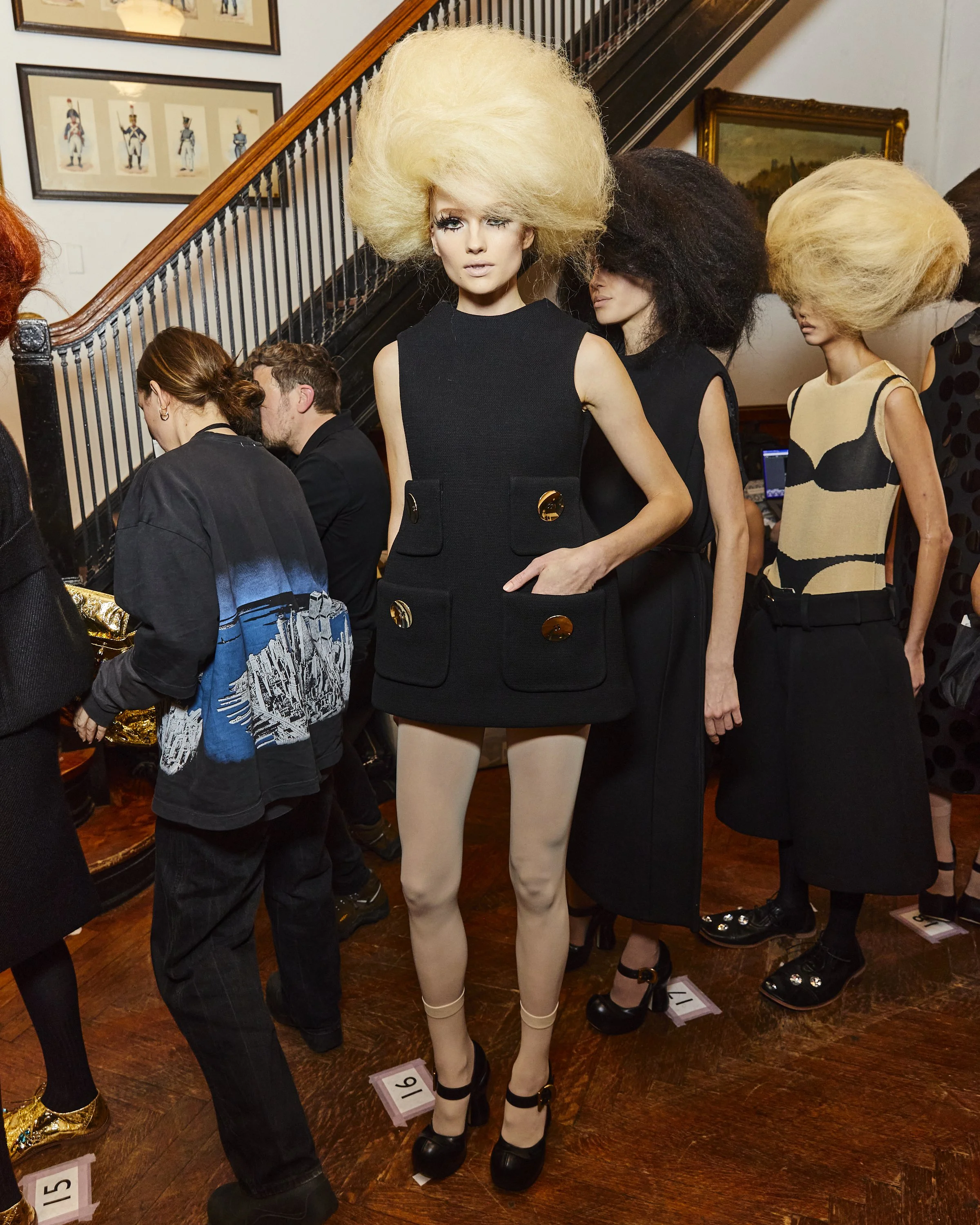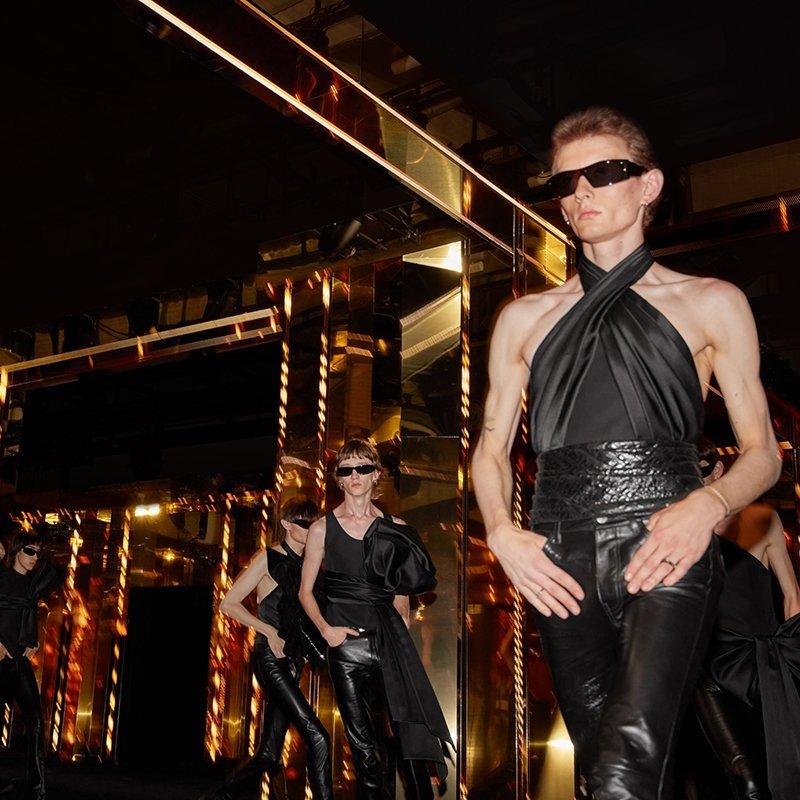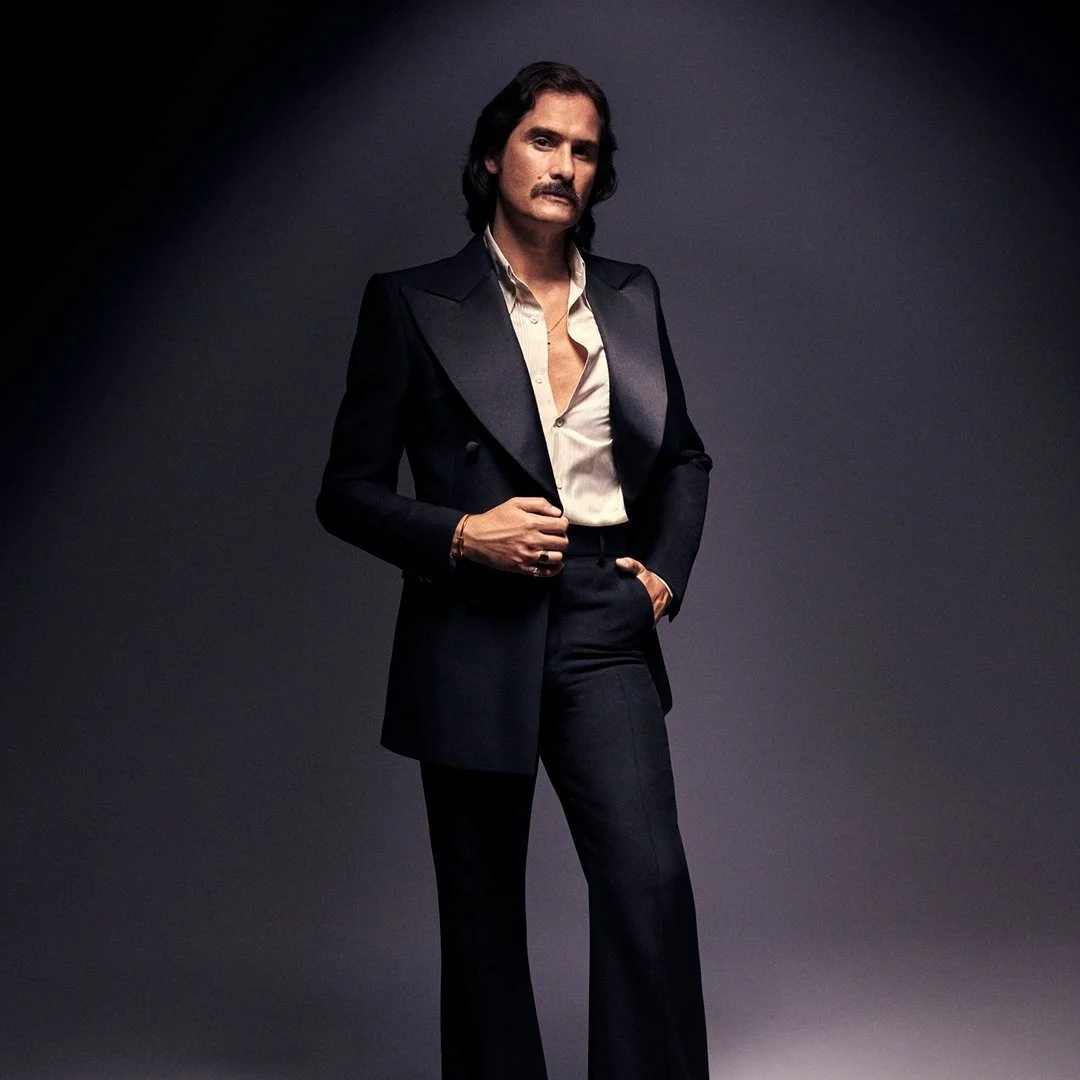Milan’s new creatives.
When Edward Buchanan first arrived in Milan – 25 years ago, at the start of a long, illustrious and savvy career in design – he was stopped at Linate airport. ‘They thought I was a drug dealer,’ he recalls with a sigh. Buchanan was born in Ohio and raised in New York. ‘I was a black kid from the Midwest. And I was stopped every day on the street.’ Buchanan had what he calls ‘the privilege’ of an American passport, so when he showed the authorities his paperwork he would mostly be greeted with sincere apologies for the mistake. ‘God knows what would’ve happened if I was Senegalese,’ he notes.
Last year, Ed helped launch the We Are Made in Italy initiative at Milan Fashion Week, a collective redress to some of the institutional racism which he has seen at first hand and intends to do something about ironing out from the Italian Fashion industry. ‘Italy is a funny space,’ he says. ‘It is business and it is religion. It is “classic”.’ His CV includes positions at Bottega Veneta, Trussardi, Calvin Klein, Max Mara and Benetton, and heading up the knitwear division of Off-White, one of the few black-owned Italian fashion businesses, under the evolutionary force and generational heroism of the late Virgil Abloh.
‘Am I proud of what I’ve done?’ he asks. ‘Absolutely, I am. Yes. But success comes in different forms. And We Are Made in Italy is speaking to some of the issues that I’ve come across since I’ve been in Milan. It’s about supporting and uplifting youth cultures, job opportunities, mentoring and reducing invisibility for Afro-Italians.’ Diversity and inclusion is a big conversation in the industry at present. Buchanan wants to help make it more than words, to start seeing the effects of direct action on Italy’s most elite export. ‘There are hurdles to get over. For the Black, Chinese and Arab populations of Milan there is a sense of exclusion. Because a lot of the industry began from small families there is a sense of division, of who belongs to what. It’s easy for people to become kind of invisible. So it’s time to spotlight them.’
Working on this Perfect project was a labour of love for Buchanan. ‘Casting was super fun!’ he says. ‘The thing that makes Italy swing in general is being a fashion Mecca. Fashion is its business. It should be an intersectional space. And these kids know what is going on. Milanese club culture is still underground. The activity of youth has been siderailed by Covid, as it has everywhere. But there are really exciting pockets of activity going on. You just have to look for them in order to elevate them.’
To be the thing, you have to see the thing. Edward Buchanan wanted to use this opportunity to give shop window space to a vital BIPOC, LGBTQIA+ population that can feel squeezed by tradition in a city and country which prides itself righteously on heritage. ‘I wanted to know what their lives are like and how they feel we need to give them a space in the conversation. This is the multicultural Milanese talent who don’t get talked about. It’s about spotlighting these kids, whether they be drag queens or stylists. This project was about looking inside out rather than outside in.’
Italy’s last moment of youth driven pop-cultural preeminence was in the late Eighties/early Nineties, when the coastal resort of Rimini became a hotbed of DIY European House music, a buoyant, optimistic noise sent out into the world from dancefloors on an ecstatic rush of positivity and good vibrations. ‘There are still those pockets and undercurrents thriving,’ says Ed. ‘These people are making fantastic work, they’re super exciting. But there is an indigenous problem with turning the diversity conversation into a reality. I am still one of the only people of colour I see sitting around a table at most meetings.’
Does he feel change can be afoot? ‘Absolutely. You can sense change in the atmosphere. Black Lives Matter happened here. The industry is aware of what’s going on. The thing that all these people have in common is Milan. This is the Milan people don’t see.’
Jury Schiavi (@juryslaves) is a make-up artist and part-time drag artist. His performance name is Sissy Galore. He is 30 (‘but feels 20!’).
How long have you lived in Milan?
I’ve lived here since 2009, with a small break in London.
What are the best and worst things about the city?
Coming from a super-small town, for me the best thing in Milan is the melting pot of people that you can meet. It’s one of the few cities in Italy where you can breathe a more European air. The worst part? Rent and life in general is quite expensive (laughs).
What inspires your work?
It could be a shape, a texture, a material. Visually I really like the work of the big Japanese illustrators, Hajime Sorayama, Yoshitaka Amano, Pater Sato, Sadao Hasegawa. I love the anime world, fantasy stories.
Who is your favourite Milanese person?
Just one? After 13 years? I love each one of my chosen family here. I love people that don’t blend in with the crowd, either for the way they look, for the work they do or the art they produce.
What is your favourite place to hang out in the city?
It has to be Plastic [the nightclub]. It’s like a second home for me. It’s a safe place where I can be who/what I want without any problem, surrounded by the best music you can find.
What does fashion mean to the city?
That would depend on the person you’re asking. Someone will say that fashion is freedom to express your true self, to communicate something new. Others see fashion as a statement of richness and opulence. For me, particularly when I am in drag, fashion represents fun. It’s a feeling of empowerment, a fantasy on your skin, a character in your mind.
What is Milanese counterculture?
It’s being unapologetically yourself, without questioning your taste, style or mood. It’s all about the people who don’t blend in with a system where the winner is always the richest, usually the whitest, straightest and most male.
What single thing would improve the city?
Really highlighting new designers and creatives to help them grow. Not just doing things to put on social media. Really caring.
Demi Oyenekan (@demioyenekan) is a 24-year-old fashion designer, stylist and content creator.
How long have you lived in Milan?
Two years, four months.
What’s the best thing about the city?
The creative aura that drives through the heart and soul of everyone living here.
What inspires your work?
My background and life experience. I believe fashion is a gift to me and my expression is a gift to the world.
Who is your favourite Milanese person?
[Singer/songwriter] David Blank. He is such a massive support to me and such an inspirational person.
What’s your favourite place to hang out in the city?
Parco Sempione, a beautiful park in the heart of Milan. I carry out a lot of research there.
What does fashion mean to the city?
It’s the heart of Milan. It has established a long history within the fields of fashion, textiles and design. As a creative, I feed off that energy.
What is Milanese counterculture and where should I go to find it?
Milanese people take fun very seriously and the hospitality companies here do an amazing job providing it. You can find good places with amazing food and drinks at Corso Como, Navigli and China Town.
What single thing would improve the city, in your opinion?
One word: education. There are people with so many different narratives. We all deserve a chance for a seat at the table.
Kobramulata (@kobramulata) is a 25-year-old artist, model and content creator.
How long have you lived in Milan?
Since December 2018.
What’s the best thing about the city?
Milan has its good and bad sides, like every city around the globe. One of the best is that, while walking around town you can meet different cultures and people from almost everywhere. There are a lot of big and beautiful parks all around the city where people often go to party together and hang out with friends. The bad things are the racism, transphobia and every type of hate against LGBTQIA+ and POC communities that unfortunately represents a big part of our everyday life.
What inspires your work?
I love music and am currently listening to Arca, Sega Bodega, Doja Cat, Caroline Polachek, Namasenda. I love female rappers like Cupcakke, La Zowi, Urias and Quay Dash. Music inspires me most while I’m painting, writing or editing some content. I like to travel into my past a lot and then be right back in the present moment, linking the emotions and sensations of the two to see what comes out.
Where’s your favourite place to hang out in the city?
It really depends on my mood. You can find me very often in the parks. Lambro park is a favourite. But I’m a night-time creature who loves to dance and party hard, too. It’s more the mood and company than the place itself. When I’m with my sisters and the right people, everywhere could be a piece of heaven on earth.
What single thing could improve the city?
More safe spaces for LGBTQIA+ and POC communities. More opportunities to tell our stories through the arts. Any way that we can feel less alone in this battle.
Lina Giselle Murillo (@gs.elle) is a 29-year-old account manager for i-D magazine, part-time model and content creator.
How long have you lived in Milan?
Since December 2019, so right before the pandemic. Yikes.
What’s the best and worst things about the city?
It gives you the opportunity to make your dreams come true. You meet so many talented people so you feel inspired by them to pursue your passions and goals. On the other side is the fact that sometimes people can be too caught up in appearance and reputation, leading them to live a superficial life with superficial relationships. I think people should focus more on who we are as human beings and not what we do, who we know or what places we go.
Who is your favourite Milanese person?
My circle is very diverse and multicultural, so yeah, I would say all of my friends because being around them makes me a better person. They are the funniest people to be around.
What’s your favourite place to hang out in the city?
I really love Porta Venezia, the neighbourhood of the LGBTQIA+ community. The energy is always right and you know it’s always going to be fun. To chill I like Parco Sempione park, especially during summer.
What does fashion mean to the city?
Fashion is the soul of Milan, it’s what makes the city so avant-garde and unique. Most of us are part of the industry or know someone who is part of it. You can always feel it everywhere you go.
What is Milanese counterculture and where should I go to find it?
Right now, minorities are the Milanese counterculture. POC, LGBTQIA+ and immigrants are the people who are moving the city forward. So you should go to Porta Venezia if you want to see their magic all together.
What single thing would improve the city?
Authenticity – that’s it.
Sasha Payton (@sashapayton_) is a 34-year-old fashion show producer and model.
How long have you lived in Milan?
Just over a year and a half. I was born and raised in New York; I was living in Paris and wanted to move back to New York, but I had a contract with a Milanese model agency to fulfil.
What inspires your work?
My roots are French Caribbean so I like experiencing life through other people’s stories.
Who is your favourite Milanese person?
Edward [Buchanan]! I feel like he’s my god-uncle. He’s given me so many opportunities since I moved from Paris and I wouldn’t know anyone without him. He’s a bridge. He understands the past, present and future and how to connect them. He’s bold and unafraid, too. A lot of people talk about switching up the conversation on diversity – he does it.
What’s your favourite place to hang out in the city?
Navigli. I like to shop thrift and there’s a market once a month. I bought a really neat leather jacket there. I like random trinkets and jewellery. It’s the same at night – aperitivo is one of the best things about the city.
What does counterculture mean to Milan?
I’m still looking for it. I know the people exist but they’re a little bit quieter than in other cities.
What single thing would improve the city?
Awareness of other cultures. Learning about other people.
Perla Isabel Ventura Hidalgo (@perlaisabel__) is a model and content creator from the Dominican Republic.
How long have you lived in Milan?
Almost five years now. I moved to the city when I started working as a model.
What’s the best thing about the city?
The variety of people. I love to see different styles, coming from different scenarios and cultures.
What inspires your work?
Mostly my emotions – those feelings I want to get out of my system and look at from a different perspective. Giving them a physical form really helps me to express and understand myself better.
Who is your favourite Milanese person?
The one that is not afraid to show who they are and to express themselves. That might be with make-up and clothing, or just being their real spontaneous self. I love creative people who are unapologetically themselves, confident and always ready to create and bring to life something new.
What is Milanese counterculture and where should I go to find it?
One of my favourite places to hang out in the city is Porta Venezia, it is the place with the LGBTQIA+ community that I absolutely love.
Lorenzo Seghezzi (@lorenzoseghezzi) is a 24-year-old designer with his own brand.
How long have you lived in Milan?
Since 1997 – I was born here.
What’s the best thing about the city?
How fast it’s changing and becoming the epicentre of Italian queer culture. I’m a proud Milanese.
What inspires your work?
Queer history. Most of my designs are homages to LGBTQIA+ culture, pioneers and icons.
Who is your favourite Milanese person?
My father, because he is my biggest supporter. I owe my creativity to him for sure.
Where is your favourite place to hang out in the city?
I'm a true ragazza di Porta Venezia, I love that neighbourhood. It’s so interesting how it’s at the same time LGBTQIA+ and an East African neighbourhood. Seeing two such different cultures supporting and living together is amazing.
What does fashion mean to the city?
It's what Milano is known for all around the world. Unfortunately, the Italian fashion culture is very bonded with classic style and lame prêt-à-porter, so a lot of tourists that come here for fashion week are usually underwhelmed. But I’m sure the new generation of more experimental designers, hopefully myself included, will spice things up.
What is Milanese counterculture and where should I go to find it?
Milanese counterculture is very big, especially queer counterculture. You have to keep in mind that Milan is probably the most aspired city to live in by young people who live in other close-minded Italian cities where they can't express themselves. Every year a lot of young people come here from all over Italy hoping to find the perfect place to blossom and express their style and point of view. That keeps the underground counterculture evolving and being fluid. There are a lot of places where you can find ‘alternative people’. It depends on what you’re looking for. For me, ‘alternative strange people’ are economics and business students in Bicocca (laughs).
What single thing would improve the city?
The underground [transport] service should work all night, at least on weekends. It would create a much safer nightlife.

























